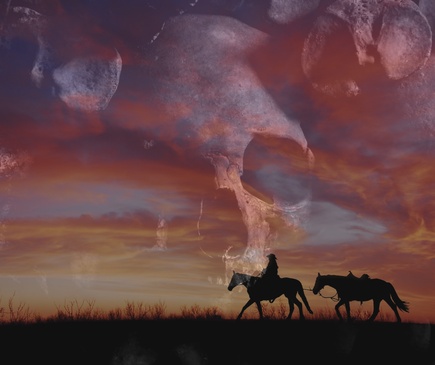|
Stunning vistas, remote wilderness, death-defying shootouts—all are elements of the western novel. Western novels entertained readers worldwide, hitting their peak in the mid-20th century; however, the genre itself has suffered a steady decline since.
Despite the decline, the western didn’t die. Publishers continued to offer western books, and Hollywood producers continued to make western films. Yet, despite the decline in popularity, the western genre survived in crossover fiction. Common themes lent themselves across multiple genres, including science-fiction (think Firefly) and horror (what I’m here to talk about). There are some fantastic authors out there that can mash genres with mastery. Some tend to be difficult (I’ve never seen a meat-punk, cozy mystery). Some are easier. This bring us to westerns and horror—they go together like rum and coke. In my opinion, the easiest piece of the puzzle is the setting. Westerns are often set in small towns or the wilderness/frontier. This is important because these places are isolated. Isolation is a common theme found in a lot of different horror novels. Look at The Shining by Stephen King. A small family left to tend a hotel in the Colorado mountains, denied easy access to town due to the snow. Or, following the cold theme, we could look at Ronald Malfi’s Snow, John Carpenter’s The Thing. All of these stories take place in settings that are isolated from society. Why is this important? Isolation adds tension. Isolation invigorates the conflict. It ups the ante with the fact that the characters have to rely on themselves and what they have at their disposal. The protagonist can’t call the cops or emergency services to help them. Food, water, and other supplies could be an issue. The setting can add a man vs. nature element that can provoke strong emotions with your readers. Westerns embody this setting with gusto. It was the forte of the genre. What would True Grit be without the vast Indian Territory? Even when the western is set in a town, the town itself is isolated from the world. Therefore, they make perfect places for horror stories because the characters can’t rely on outside help to arrive soon. Communication was very limited during the period, and getting news in or out was a process. Let’s take this a step further—the genre of post-apocalyptic horror and westerns are basically cousins. The frontier town and the post-apocalyptic community share the same feel. For example, they both have a lot of dirt. Westerns are dirty and gritty. Think of any western film you’ve watched. Now imagine any post-apocalyptic film. The characters are always just as dirty. Remember, cleanliness is a luxury in both settings. They also share the isolation I mentioned earlier. With the expansion of the West, most people were situated in the East as the explorers, pioneers, and frontiersmen blazed the way. With the post-apocalyptic piece, most of the population will have disappeared, or at very least, found pockets to live in. This leaves your character a chance to get out and explore the wilderness with little chance of running into anyone. This leads to my next point—suspense. Every meeting with other people in either setting is dangerous. You don’t know if the people out there are other explorers, simple travelers, bandits, murderers, or cannibals ready to eat you and wear your face as a mask. Keep that in the back of your mind as you spin your tale. Post-apocalyptic horror aside, westerns work great as horror because of their familiarity. Cowboys and the Old West have carved out a home in almost everyone’s imagination. It doesn’t matter where you’re from; show someone a picture of a man on a horse with a ten-gallon hat and gun, and there’s a good chance that they can associate that image with cowboys. It’s in that familiarity that you can use to put the reader at ease. We like to find things familiar when we read, even when it’s a fantastic science fiction adventure. Authors use themes, images, symbols to find familiar ground with the reader. Once you’ve set that familiarity with the reader, you can start ripping it away with the horror. Westerns and horror are making a big comeback these days. Take a look at Death’s Head Press and their Splatter Punk line or movies like Bone Tomahawk. Combining the two genres makes perfect sense, and when done well, can create a rousing, creepy tale. Horror works because it shakes our foundation of reality, but we can’t shake that foundation until we’ve built it. Let the Old West be that foundation, and have fun with it. Now go write and submit us some horror westerns! Comments are closed.
|
Archives
June 2024
Categories
All
|

 RSS Feed
RSS Feed